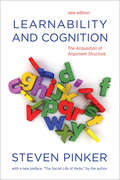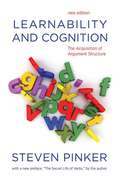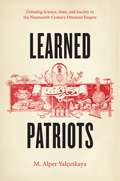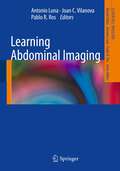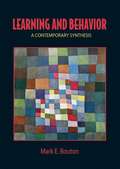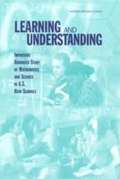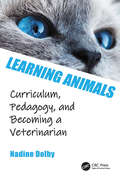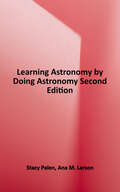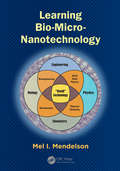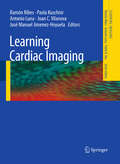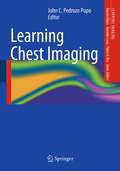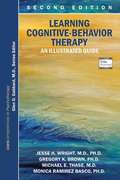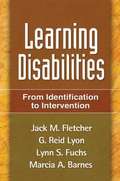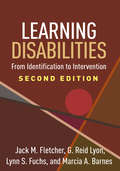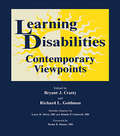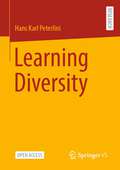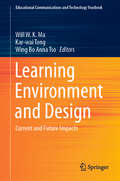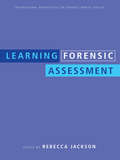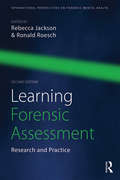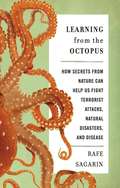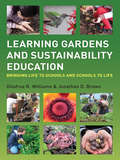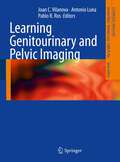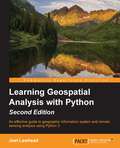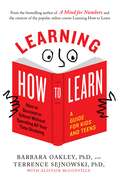- Table View
- List View
Learnability and Cognition, new edition: The Acquisition of Argument Structure (Learning, Development, and Conceptual Change)
by Steven PinkerA classic book about language acquisition and conceptual structure, with a new preface by the author, "The Secret Life of Verbs."Before Steven Pinker wrote bestsellers on language and human nature, he wrote several technical monographs on language acquisition that have become classics in cognitive science. Learnability and Cognition, first published in 1989, brought together two big topics: how do children learn their mother tongue, and how does the mind represent basic categories of meaning such as space, time, causality, agency, and goals? The stage for this synthesis was set by the fact that when children learn a language, they come to make surprisingly subtle distinctions: pour water into the glass and fill the glass with water sound natural, but pour the glass with water and fill water into the glass sound odd. How can this happen, given that children are not reliably corrected for uttering odd sentences, and they don't just parrot back the correct ones they hear from their parents? Pinker resolves this paradox with a theory of how children acquire the meaning and uses of verbs, and explores that theory's implications for language, thought, and the relationship between them.As Pinker writes in a new preface, "The Secret Life of Verbs," the phenomena and ideas he explored in this book inspired his 2007 bestseller The Stuff of Thought: Language as a Window into Human Nature. These technical discussions, he notes, provide insight not just into language acquisition but into literary metaphor, scientific understanding, political discourse, and even the conceptions of sexuality that go into obscenity.
Learnability and Cognition: The Acquisition of Argument Structure (new edition)
by Steven PinkerBefore Steven Pinker wrote bestsellers on language and human nature, he wrote severaltechnical monographs on language acquisition that have become classics in cognitive science. Learnability and Cognition, first published in 1989, brought together two bigtopics: how do children learn their mother tongue, and how does the mind represent basic categoriesof meaning such as space, time, causality, agency, and goals? The stage for this synthesis was setby the fact that when children learn a language, they come to make surprisingly subtle distinctions:pour water into the glass and fill the glass with water soundnatural, but pour the glass with water and fill water into theglass sound odd. How can this happen, given that children are not reliably corrected foruttering odd sentences, and they don't just parrot back the correct ones they hear from theirparents? Pinker resolves this paradox with a theory of how children acquire the meaning and uses ofverbs, and explores that theory's implications for language, thought, and the relationship betweenthem. As Pinker writes in a new preface, "The Secret Life of Verbs," thephenomena and ideas he explored in this book inspired his 2007 bestseller The Stuff ofThought: Language as a Window into Human Nature. These technical discussions, he notes,provide insight not just into language acquisition but into literary metaphor, scientificunderstanding, political discourse, and even the conceptions of sexuality that go intoobscenity.
Learned Patriots: Debating Science, State, and Society in the Nineteenth-Century Ottoman Empire
by M. Alper YalcinkayaThe nineteenth century was, for many societies, a period of coming to grips with the growing, and seemingly unstoppable, domination of the world by the "Great Powers” of Europe. The Ottoman Empire was no exception: Ottomans from all walks of life--elite and non-elite, Muslim and non-Muslim--debated the reasons for what they considered to be the Ottoman decline and European ascendance. One of the most popular explanations was deceptively simple: science. If the Ottomans would adopt the new sciences of the Europeans, it was frequently argued, the glory days of the empire could be revived. In Learned Patriots, M. Alper Yalçinkaya examines what it meant for nineteenth-century Ottoman elites themselves to have a debate about science. Yalçinkaya finds that for anxious nineteenth-century Ottoman politicians, intellectuals, and litterateurs, the chief question was not about the meaning, merits, or dangers of science. Rather, what mattered were the qualities of the new "men of science. ” Would young, ambitious men with scientific education be loyal to the state? Were they "proper” members of the community? Science, Yalçinkaya shows, became a topic that could hardly be discussed without reference to identity and morality. Approaching science in culture, Learned Patriots contributes to the growing literature on how science travels, representations and public perception of science, science and religion, and science and morality. Additionally, it will appeal to students of the intellectual history of the Middle East and Turkish politics.
Learning Abdominal Imaging
by Joan C. Vilanova Antonio Luna Pablo R. RosThis book is an ideal introduction to the use of radiology in imaging diseases of the liver, gallbladder and biliary system, pancreas, spleen, and gastrointestinal tract. Each of the ten chapters is devoted to a particular organ and contains ten illustrated case reports drawn from clinical practice. Common clinical situations and indications for imaging are reviewed, and clear descriptions are provided of the various imaging techniques that will assist in resolving diagnostic and therapeutic dilemmas. This book is recommended for medical students, residents, and inexperienced abdominal radiologists.
Learning About Matter (Science 2012 Leveled Reader #Grade 5 On-level)
by Scott ForesmanScience 2012 Leveled Reader Grade 5 On-level: Learning About Matter
Learning And Behavior: A Contemporary Synthesis
by Mark E. BoutonProviding a strong background in modern learning and behavior theory, this book reflects the importance of the study of animal learning in psychology. Topics covered include learning and adaptation, modern conditioning theories, memory retrieval, instrumental learning, avoidance learning and learned helplessness.
Learning And Understanding: Improving Advanced Study Of Mathematics And Science In U.s. High Schools
by Committee on Programs for Advanced Study of Mathematics Science in American High SchoolsThis book takes a fresh look at programs for advanced studies for high school students in the United States, with a particular focus on the Advanced Placement and the International Baccalaureate programs, and asks how advanced studies can be significantly improved in general. It also examines two of the core issues surrounding these programs: they can have a profound impact on other components of the education system and participation in the programs has become key to admission at selective institutions of higher education.By looking at what could enhance the quality of high school advanced study programs as well as what precedes and comes after these programs, this report provides teachers, parents, curriculum developers, administrators, college science and mathematics faculty, and the educational research community with a detailed assessment that can be used to guide change within advanced study programs.
Learning Animals: Curriculum, Pedagogy and Becoming a Veterinarian
by Nadine DolbyWe are surrounded by thousands of animals, alive and dead. They are an intimate and ever-present part of our human lives. As a society, we privilege veterinarians as experts on these animals: they are our educators and teachers in what they say, what they do, and the decisions that they make. Yet, within the field of education, there is little research on the curriculum, pedagogy, and experiences of veterinary school and students. What do veterinarians learn in veterinary school? How do their experiences during those four years shape their perceptions of animals? How do the structures, curriculum, and pedagogy of veterinary college create and influence these experiences? Learning Animals opens up this conversation through an exploration of the complicated, fascinating and often painful stories of a cohort of veterinary students as they make their four-year journey from matriculation through graduation. The book examines how the experiences of veterinary students shape how humans relate to animals, from public policy and decision-making about the environment and animals slaughtered for food, to the most personal decisions about euthanizing companion animals. The first full-length, critical, qualitative study of the perspectives of our primary teachers about animals, this will be a thought-provoking read for those in the fields of both educational research and veterinary education.
Learning Astronomy by Doing Astronomy: Collaborative Lecture Activities, Second Edition
by Stacy Palen Ana M. LarsonResearch shows that students learn best by doing. This workbook, written by two master teachers, contains 36 field-tested activities, including nine new to the Second Edition, that span the introductory astronomy course and can be used in any size classroom. Each activity is now self-contained with an introduction that provides necessary background material for students. Activities are built around a concept that leads students from basic knowledge to a deeper understanding through guided interactions. The Second Edition is supported by Smartwork5, so instructors can easily assess student understanding.
Learning Bio-Micro-Nanotechnology
by Mel I. MendelsonLearning Bio-Micro-Nanotechnology is a primer on micro/nanotechnology that teaches the vocabulary, fundamental concepts, and applications of micro/nanotechnology in biology, chemistry, physics, engineering, electronics, computers, biomedicine, microscopy, ethics, and risks to humankind. It provides an introduction into the small world with a low fo
Learning Cardiac Imaging
by Ramón Ribes Joan C. Vilanova Antonio Luna José Manuel Jimenez-Hoyuela Paola KuschnirThis book is an introduction to cardiac imaging. Written by radiologists, cardiologists, and nuclear medicine physicians in a user-friendly format, it provides the reader with a multidisciplinary selection of the most prevalent cardiac conditions. The book is subdivided into four sections: Cardiac Multislice CT, Echocardiography, Cardiac Magnetic Resonance and Nuclear Cardiology. Each chapter is presented with an introduction to the subspecialty and a selection of cases with illustrations, comments from clinical and radiological standpoints, and bibliographical recommendations.
Learning Chest Imaging
by John C. Pedrozo PupoRadiology of the thorax forms an indispensable element of the basic diagnostic process for many conditions and is of key importance in a variety of medical disciplines. This user-friendly book provides an overview of the imaging techniques used in chest radiology and presents numerous instructive case-based images with accompanying explanatory text. A wide range of clinical conditions and circumstances are covered with the aim of enabling the reader to confidently interpret chest images by correctly identifying structures of interest and the causes of abnormalities. This book, which will be an invaluable learning tool, forms part of the Learning Imaging series for medical students, residents, less experienced radiologists, and other medical staff.
Learning Cognitive-Behavior Therapy: An Illustrated Guide (Core Competencies in Phychotherapy Ser.)
by Glen O. Gabbard Michael E. Thase Jesse H. Wright Monica Ramirez Basco Gregory K. BrownBuilding on its successful -read-see-do- approach, this second edition of Learning Cognitive-Behavioral Therapy: An Illustrated Guide seamlessly combines 23 all-new videos with informative text and figures, charts, worksheets, checklists, and tables to help readers not only learn the essential skills of CBT but achieve competence in this important evidence-based treatment method. <P><P>Opening with an overview of core cognitive-behavior therapy (CBT) theories and techniques, leading CBT practitioners then describe and demonstrate how to build effective therapeutic relationships with CBT, conceptualize a case with the CBT model, structure sessions, and resolve common problems encountered in CBT. <P><P>This updated, second edition of the best-selling and highly popular Learning Cognitive-Behavioral Therapy also features: - Ways to employ CBT to reduce suicide risk- Guidance on integrating therapies related to CBT -- including dialectical behavior therapy, mindfulness-based cognitive therapy, and well-being therapy -- in the context of personality disorders and chronic or recurrent depression- An appendix of curated resources by the expert authors -- recommended readings, computer programs, Web sites, videos, and organizations -- to give readers access to the best resources in building competence in CBT practice <P><P>The all-new videos feature clinicians demonstrating methods in real-world settings and include new topics such as safety planning and uncovering and changing maladaptive schemas. Proven as one of the best teaching tools for building competence in CBT, this new edition will enrich readers' understanding and practice of CBT.
Learning Disabilities
by G. Reid Lyon Jack FletcherEvidence based and comprehensive, this important work offers a new approach to understanding and intervening with students with learning disabilities. The authors--leading experts in neuropsychology and special education--present a unique model of learning disabilities that integrates the cognitive, neural, genetic, and contextual factors associated with these disorders. The volume addresses classification, assessment, and intervention for a range of disabilities involved in reading, mathematics, and written expression. With a focus on exploring the evolving scientific base of the field, as well as establishing effective educational practices, this book will serve as an essential text and an indispensable resource for school psychologists, neuropsychologists, special educators, and others who work with struggling learners.
Learning Disabilities, Second Edition: From Identification to Intervention
by Marcia A. Barnes G. Reid Lyon Jack M. Fletcher Lynn S. FuchsReviewing the state of the science of learning disabilities (LDs) and describing effective educational practices, this authoritative volume has been significantly revised and expanded with more than 70% new material. Foremost LD experts identify effective principles of assessment and instruction within the framework of multi-tiered systems of support (MTSS). With a focus on what works in the classroom, the book explores the full range of reading, mathematics, and writing disabilities. It synthesizes knowledge from neuropsychology, cognitive neuroscience, and special and general education. Illustrations include eight color plates. As a special supplement, a chapter on the history of the LD field from the first edition is provided at the companion website. New to This Edition *Heightened emphasis on intervention, including significant new developments in reading comprehension and math. *Reflects major scientific advances in understanding LDs. *Chapter on principles of effective instruction and MTSS. *Chapter on automaticity in reading, math, and writing. *Chapter on challenges in real-world implementation of evidence-based practices. *Chapter on the validity of the LD construct.
Learning Disabilities: Contemporary Viewpoints
by Brian J. Cratty Richard L. GoldmanThis volume examines the field of learning disabilities and the education of learning disabled (LD) children through the eyes of several experts. Contributors bring to the book such diverse academic backgrounds as education, psychology, special education and medicine. The chapters, adapted from lectures given at the Landmark West School in California, include audience questions and responses. Chapters on new medications for the LD child, contemporary research on dyslexia and educational strategies for improving reading are complemented bychapters on social and emotional issues that affect the families of learning disabled children, adolescents and young adults.
Learning Diversity
by Hans Karl PeterliniThis Open-Access-book explores diversity in its ambivalence. On the one side, we love to describe diversity as a resource for personal, social, economic, and cultural growth. On the other side, categories of differences often lead to discrimination or serve as justifications for privileges. They can cause exclusion and, conversely, promote the self-constitution of discriminated subjects and groups.The book moves within this tension of exclusion and belonging. Case studies of young ethnicized people vividly depict the interwovenness of identity-building and diversity. Theoretically, the book examines the psychosocial and anthropological conditions for constructing the Other. Sharp divisions between We and the Other, between social and national groups, and between humans and nature have devastating, life-threatening consequences. Dichotomous split-offs divide people, nations and the whole world. So, how do we deal with diversity? The author does not provide simple recipes but engages in a phenomenology of diversity that does not press life and its manifestations into categories but keeps them in a limbo of attention by affirming and doubting differences.
Learning Environment and Design: Current and Future Impacts (Educational Communications and Technology Yearbook)
by Wing Bo Anna Tso Will W. K. Ma Kar-Wai TongThis special edition of the Educational Communications and Technology Yearbook Series bears a title of “Learning Environment and Design: Current and Future Impact”. It provides a timely forum to share theoretical and practical insights in both the local and international contexts in response to the fact that new media and technologies have infiltrated and shaped the learning environments from mere physical spaces into multifaceted possibilities, impacting the ways individuals teach and learn. Designs of learning environments to harness technologies appropriately to engage learners better, as well as the roles of learners and educators play in this changing learning environment, are examples of important global issues in the discourse of the contemporary educational developments. Having gathered a diverse collection of research papers written by scholars and practitioners in the fields of education, communication and humanities across Asia, Australasia, Europe and the United States, this book gives readers a cross-cultural background on the developments of technological designs and educational practices, investigating areas in redefining of quality education; online learning and blended learning; new media in education; gamification, AI, and innovative learning technologies. Aimed to catalyze knowledge exchanges and provide fresh views on interdisciplinary research, the book sheds light on how emerging technologies can be adapted in the fields of education and communication, so as to facilitate the current and future designs of learning environments to improve learners’ performances.
Learning Forensic Assessment
by Rebecca JacksonProviding an excellent resource for forensic psychology undergraduate students, this book offers students the opportunity to learn from experts, through the collection of outstanding articles. Unlike other books in the area that are topic specific, it also gives them comprehensive coverage of the subject. Divided into five broad topic areas, it covers: professional issues juvenile assessment criminal forensic assessment civil forensic assessment pervasive issues – malingering and psychopathy. Written by a group of internationally renowned contributors and including didactic information as well as providing discussions on practical issues regarding assessment and assessment instruments, this textbook will be invaluable reading for all students of forensic psychology.
Learning Forensic Assessment: Research and Practice (International Perspectives on Forensic Mental Health)
by Rebecca Jackson and Ronald RoeschMajor developments in the field since the publication of Learning Forensic Assessment are integrated in this revised edition, including revised editions of the DSM-5, HCR-20 scale, and child custody guidelines. This textbook is designed for graduate students learning forensic assessment and psychologists coming to forensic practice later in their careers. It is organized around five broad areas: Professional and Practice Issues, Adult Forensic Assessment, Juvenile Forensic Assessment, Civil Forensic Assessment, and Communicating Your Findings. Each chapter begins with a strong teaching and learning foundation. The latter part of each chapter is assessment specific, covering available assessment measures and approaches to assessment. The authors go well beyond simple descriptions of assessment measures and provide a conceptual discussion of the evaluation process that helps the reader understand how assessment measures fit into the overall evaluation process. The evaluation component is geared toward assessing the important aspects of the construct as laid out in the early part of each chapter. Each chapter then concludes with a case example to illustrate the measures and techniques described.
Learning From the Octopus: How Secrets from Nature Can Help Us Fight Terrorist Attacks, Natural Disasters, and Disease
by Rafe SagarinDespite the billions of dollars we've poured into foreign wars, homeland security, and disaster response, we are fundamentally no better prepared for the next terrorist attack or unprecedented flood than we were in 2001. Our response to catastrophe remains unchanged: add another step to airport security, another meter to the levee wall. This approach has proved totally ineffective: reacting to past threats and trying to predict future risks will only waste resources in our increasingly unpredictable world. In Learning from the Octopus, ecologist and security expert Rafe Sagarin rethinks the seemingly intractable problem of security by drawing inspiration from a surprising source: nature. Biological organisms have been living--and thriving--on a risk-filled planet for billions of years. Remarkably, they have done it without planning, predicting, or trying to perfect their responses to complex threats. Rather, they simply adapt to solve the challenges they continually face. Military leaders, public health officials, and business professionals would all like to be more adaptable, but few have figured out how. Sagarinargues that we can learn from observing how nature is organized, how organisms learn, how they create partnerships, and how life continually diversifies on this unpredictable planet. As soon as we dip our toes into a cold Pacific tidepool and watch what we thought was a rock turn into an octopus, jetting away in a cloud of ink, we can begin to see the how human adaptability can mimic natural adaptation. The same mechanisms that enabled the octopus's escape also allow our immune system to ward off new infectious diseases, helped soldiers in Iraq to recognize the threat of IEDs, and aided Google in developing faster ways to detect flu outbreaks. While we will never be able to predict the next earthquake, terrorist attack, or market fluctuation, nature can guide us in developing security systems that are not purely reactive but proactive, holistic, and adaptable. From the tidepools of Monterey to the mountains of Kazakhstan, Sagarin takes us on an eye-opening tour of the security challenges we face, and shows us how we might learn to respond more effectively to the unknown threats lurking in our future.
Learning Gardens and Sustainability Education: Bringing Life to Schools and Schools to Life
by Jonathan Brown Dilafruz WilliamsOffering a fresh approach to bringing life to schools and schools to life, this book goes beyond touting the benefits of learning gardens to survey them as a whole-systems design solution with potential to address myriad interrelated social, ecological, and educational issues. The theoretical and conceptual framework presented creatively places soil at the center of the discourse on sustainability education and learning garden design and pedagogy. Seven elements and attributes of living soil and learning gardens are presented as a guide for sustainability education: cultivating a sense of place; fostering curiosity and wonder; discovering rhythm and scale; valuing biocultural diversity; embracing practical experience ; nurturing interconnectedness. The living soil of learning gardens forms the basis of a new metaphoric language serving to contest dominant mechanistic metaphors presently influencing educational discourse. Student voices and examples from urban schools provide practical understanding of how bringing life to schools can indeed bring schools to life.
Learning Genitourinary and Pelvic Imaging
by Joan C. Vilanova Antonio Luna Pablo R. RosThis introduction to genitourinary and pelvic radiology is a further volume in the Learning Imaging series. Written in a case-based format, the book is subdivided into ten chapters: kidney; adrenal gland; urinary bladder, collecting system and urethra; prostate and seminal vesicles; scrotum; obstetrics; uterus; cervix and vagina; adnexa and retroperitoneum. Genitourinary radiology has undergone a tremendous change owing to advances in ultrasound, CT and MRI that have redefined our understanding of genitourinary and pelvic pathology. Each chapter includes an introduction and ten case studies with illustrations and comments from anatomical, physiopathological and radiological standpoints and with bibliographic recommendations.
Learning GeoSpatial Analysis with Python - Second Edition
by Joel LawheadAn effective guide to geographic information systems and remote sensing analysis using Python 3 About This Book * Construct applications for GIS development by exploiting Python * This focuses on built-in Python modules and libraries compatible with the Python Packaging Index distribution system--no compiling of C libraries necessary * This practical, hands-on tutorial teaches you all about Geospatial analysis in Python Who This Book Is For If you are a Python developer, researcher, or analyst who wants to perform Geospatial, modeling, and GIS analysis with Python, then this book is for you. Familarity with digital mapping and analysis using Python or another scripting language for automation or crunching data manually is appreciated What You Will Learn * Automate Geospatial analysis workflows using Python * Code the simplest possible GIS in 60 lines of Python * Mold thematic maps with Python tools * Get hold of the various forms that geospatial data comes in * Produce elevation contours using Python tools * Create flood inundation models * Apply Geospatial analysis to find out about real-time data tracking and for storm chasing In Detail Geospatial Analysis is used in almost every field you can think of from medicine, to defense, to farming. This book will guide you gently into this exciting and complex field. It walks you through the building blocks of geospatial analysis and how to apply them to influence decision making using the latest Python software. Learning Geospatial Analysis with Python, 2nd Edition uses the expressive and powerful Python 3 programming language to guide you through geographic information systems, remote sensing, topography, and more, while providing a framework for you to approach geospatial analysis effectively, but on your own terms. We start by giving you a little background on the field, and a survey of the techniques and technology used. We then split the field into its component specialty areas: GIS, remote sensing, elevation data, advanced modeling, and real-time data. This book will teach you everything you need to know about, Geospatial Analysis from using a particular software package or API to using generic algorithms that can be applied. This book focuses on pure Python whenever possible to minimize compiling platform-dependent binaries, so that you don't become bogged down in just getting ready to do analysis. This book will round out your technical library through handy recipes that will give you a good understanding of a field that supplements many a modern day human endeavors. Style and approach This is a practical, hands-on tutorial that teaches you all about Geospatial analysis interactively using Python.
Learning How to Learn: How to Succeed in School Without Spending All Your Time Studying; A Guide for Kids and Teens
by Barbara Oakley Terrence Sejnowski Alistair McConvilleA surprisingly simple way for students to master any subject--based on one of the world's most popular online courses and the bestselling book A Mind for NumbersA Mind for Numbers and its wildly popular online companion course "Learning How to Learn" have empowered more than two million learners of all ages from around the world to master subjects that they once struggled with. Fans often wish they'd discovered these learning strategies earlier and ask how they can help their kids master these skills as well. Now in this new book for kids and teens, the authors reveal how to make the most of time spent studying. We all have the tools to learn what might not seem to come naturally to us at first--the secret is to understand how the brain works so we can unlock its power. This book explains: * Why sometimes letting your mind wander is an important part of the learning process * How to avoid "rut think" in order to think outside the box * Why having a poor memory can be a good thing * The value of metaphors in developing understanding * A simple, yet powerful, way to stop procrastinatingFilled with illustrations, application questions, and exercises, this book makes learning easy and fun.
